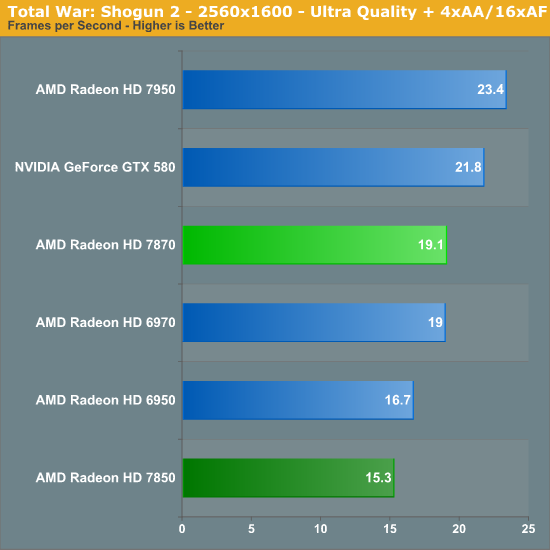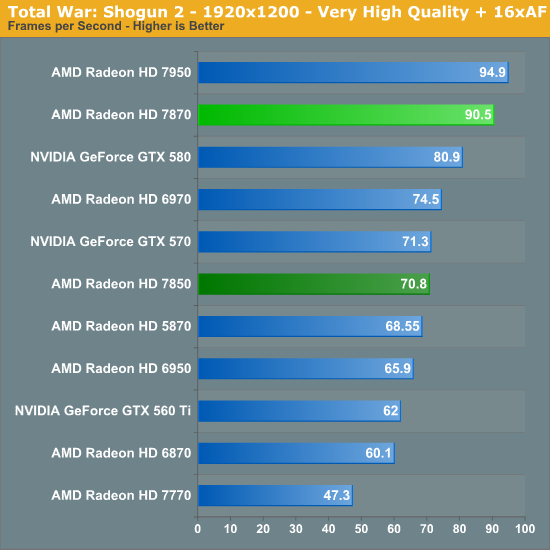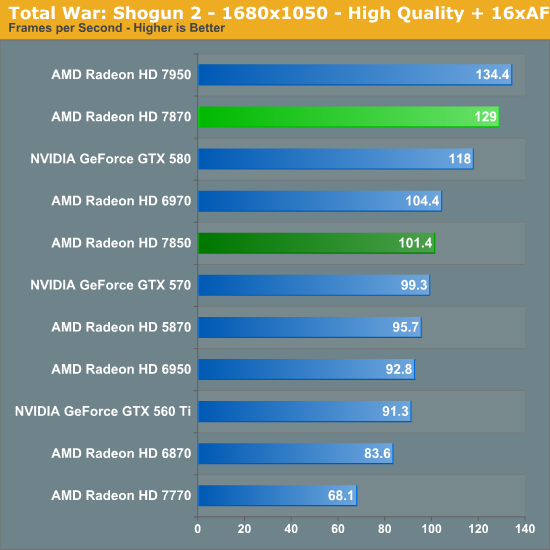AMD Radeon HD 7870 GHz Edition & Radeon HD 7850 Review: Rounding Out Southern Islands
by Ryan Smith on March 5, 2012 12:01 AM ESTTotal War: Shogun 2
Total War: Shogun 2 is the latest installment of the long-running Total War series of turn based strategy games, and alongside Civilization V is notable for just how many units it can put on a screen at once. As it also turns out, it’s the single most punishing game in our benchmark suite (on higher end hardware at least).



Shogun 2 ends up being an interesting benchmark for the 7800 series today for a number of different reasons. First and foremost of course is a strong performance lead for the 7800 compared to both the 6900 series and NVIDIA’s lineup. The 7870 leads the GTX 570 by 26%, and even the GTX 580 is over 10% slower. At the same time the 7850 ties the GTX 570, while taking a smaller 14% lead over the GTX 560 Ti.
More importantly however, it’s the first test in our suite where even the 1.25GB of VRAM on the GTX 570 isn’t enough. One of AMD’s planks for marketing the 7800 series will be that they have 2GB of VRAM versus 1.25GB on the GTX 570 or 1GB on the GTX 560 Ti, and this is a showcase of that difference. Shogun 2 knows how much VRAM it needs for any given setting configuration and won’t run on cards that don’t meet the requirements – as a result the GTX 570 and GTX 560 Ti can’t even compete at 2560. This is admittedly a higher resolution than most of the cards were designed for, but it showcases the importance of moving beyond 1GB of VRAM going forward. Between Shogun, BF3, and Skyrim, we’re seeing modern games that need 1.5GB of VRAM or more to fully spread their wings.










173 Comments
View All Comments
DeViLzzz - Monday, March 5, 2012 - link
It is not the dumbest statement ever. Have you looked at multiple sites benchmarks ? Clearly a 2 GB 6950 Power Color flashed to a 6970 or a 6970 is worth keeping. Hardly an improvement over those situations for the price you would be paying for a 7870 and 7850.ExarKun333 - Monday, March 5, 2012 - link
Then you don't follow the graphic card industry very well at all.MadAd - Monday, March 5, 2012 - link
did i just read a different review? looking at this i did - Im on the 6950 and no theres not enough performance difference.also, comparing apples to oranges and saying theres a gain isnt going to work - if someones going to OC a 7*** then im sure they have also OC their 6***, so comparing a straight 6*** to the 7*** OC results and calling it a difference is smoke and mirrors.
cactusdog - Monday, March 5, 2012 - link
You guys dont get it. Why are you comparing the 7870 to a 6950? Should be the 6870 but even then The 7870 smashes the 6950 when overclocked. the 7870 performs like a stock 7970 when overclocked. You cant compare overclocking on the 6 series to the 7 series. The 7 series is the sandy bridge of GPUs.Why compare last gens high end to this gens mid range? If you have a 6950/6970 you should be looking at a 7950/7970. A 7950/7970 will give you 70% increase in performance when overclocked. AMD left heaps of overclocking headroom for easy overclocking.
Sure, the price is a little high now, but just wait a few weeks until Nvidia cards arrive and prices will come down. New tech is always a little expensive when it first comes out but no one is forcing you to buy now. Just wait a couple of weeks
Kiste - Tuesday, March 6, 2012 - link
"Why compare last gens high end to this gens mid range?"Because were introduced at the same price point. Video card names/numbers are completely arbitrary, you have to compare cards at a given price point.
xrror - Monday, March 5, 2012 - link
So I have one the the early 6950 2GB cards unlocked to 1536 shaders, and a 935/1275 overclock.Running at 1920x1200 in skyrim with the high resolution texture packs from Bethesda starts to lag.
Yes I'm being petty, but as a PC gaming smoe, I'm looking for a card that's under $300 that will dominate what I have.
I can't find a confident vote for a strong successor in the sub $300 range to replace my current card.
This makes me sad. Also with all the growing pains 69xx series had - and AMD's dumping of VLIW4 makes me pretty sure 69xx is a dead end for any future driver improvements.
Maybe I can sell my 6950 for $100 to subsidize a 79xx or a Kepler?
Zoomer - Wednesday, March 7, 2012 - link
I'll take it.mpschan - Monday, March 5, 2012 - link
I'd tend to agree with your assessment. Only those looking for bleeding edge performance should consider the upgrade to the 7900 series.The price/performance curve is a little disappointing, but not unexpected. This is what happens when you:
a) Move to a new process
b) Implement a new architecture
c) (Most importantly) Have no competition
They need to make their money back on the first two, and having no competition allows them to do that and then some.
But look at the thermals and power draw. Decreased power usage with a small gain in performance? Where have I seen that before ... oh I know, Intel!
Welcome to tick-tock folks. They took their process shrink and used it to allow them to draw less power, not tear up the performance charts.
This means the next generation on 28nm has room to expand. 1280 SP for the 7870 can be 1600 for the 8870. A 212mm2 die can be 300mm2. 190w can be 220w.
Ultimately the performance of these cards will come down to power drawn. The huge jumps in performance that we used to see existed because of drastically improving fabrication technologies combined with better ways of rendering screens. I think those days will be few and far between now.
arjuna1 - Monday, March 5, 2012 - link
You have a point, this generation is not worth spending the $$$ to "sidegrade". I don't kepler doing anything to change that other than forcing AMD to have decent prices.cactusdog - Monday, March 5, 2012 - link
How is a 7950/7970 a "sidegrade"?? To a 6950/6970? Its a massive performance increase. If you have a highend 6 series GPU you should be looking at highend 7 series. Not midrange.